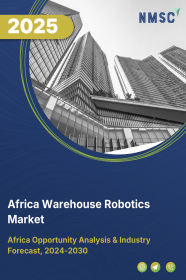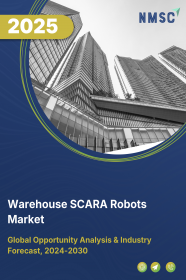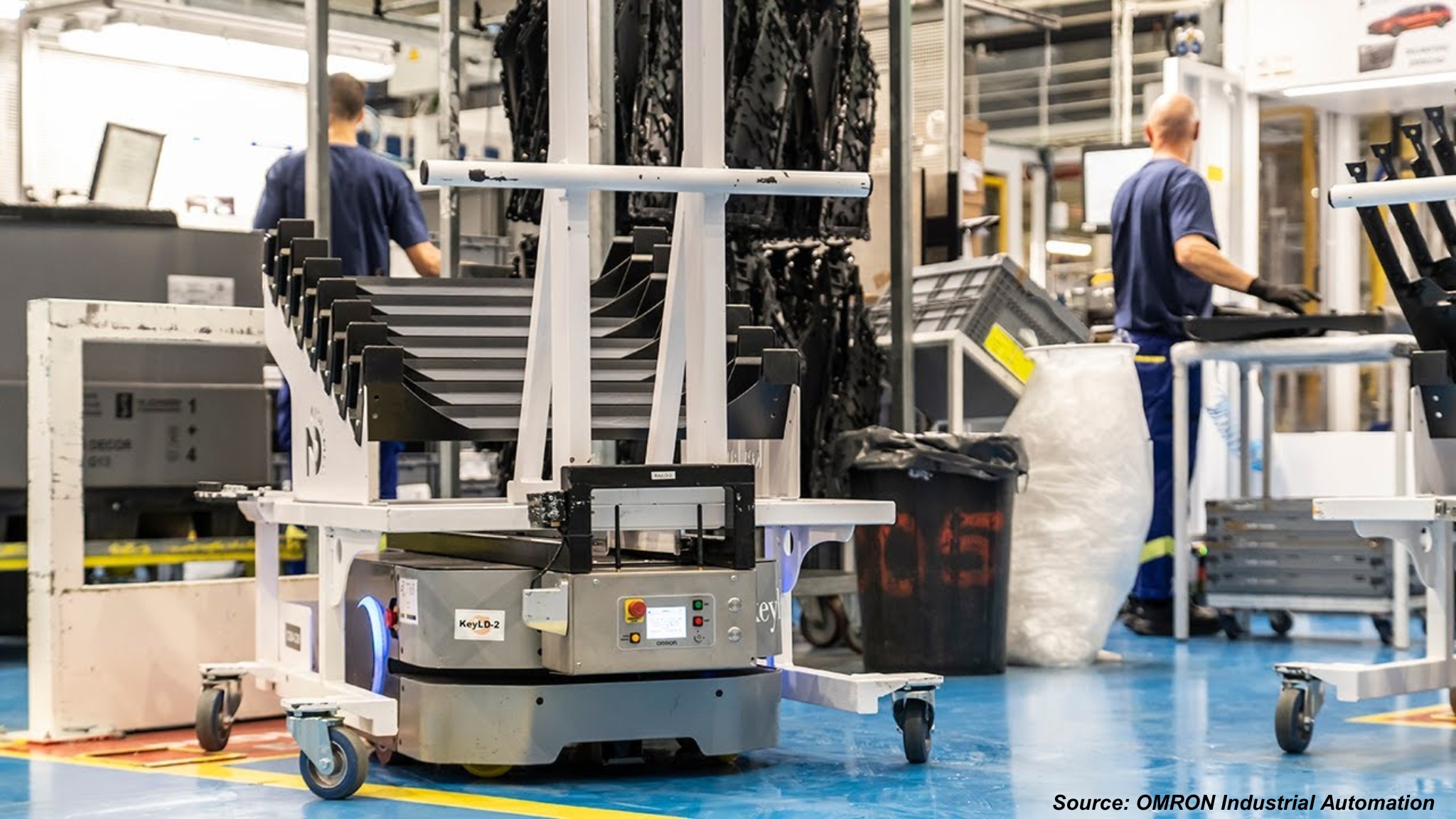
Africa Warehouse Robotics Market by Type (Automated Guided Vehicles (AGVs), Autonomous Mobile Robots (AMRs), Articulated Robots, & Others), by Offering (Hardware, Software, & Services), by Payload Capacity (Less than 100 KG, 101-200 KG, 201-500 KG, & Others), by Application (Palletizing and Depalletizing, Sorting and Packaging, Picking and Placing, & Transportation) and by End-User (E-commerce, Automotive, Food & Beverages, & Others) – Opportunity Analysis and Industry Forecast, 2025–2030
Industry: Semiconductor & Electronics | Publish Date: 29-Apr-2025 | No of Pages: 329 | No. of Tables: 236 | No. of Figures: 193 | Format: PDF | Report Code : SE3132
Africa Warehouse Robotics Market Overview
The Africa Warehouse Robotics Market size was valued at USD 244.2 million in 2024, and is predicted to reach USD 676.6 million by 2030, at a CAGR of 17.5% from 2025 to 2030.In terms of volume, the market size was 11.10 thousand units in 2024 and is projected to reach 33.14 thousand units by 2030, with a CAGR of 18.8% from 2025 to 2030
Africa’s expansion of the e-commerce industry acts as a driver for warehouse robotics market and also active Government initiatives regarding industrialization and automation also acts as a driver. Automated solutions such as robotic pickers, automated guided vehicles (AGVs), and autonomous mobile robots (AMRs) help mitigate labour gaps by restructuring inventory management, order fulfilment, and material management.
However, high initial investment required to deploy these advanced systems is one of the important factors restraining the growth limit the widespread deployment of warehouse robotics, reducing overall market growth in the region. On the contrary, introduction of artificial intelligence creates future option for the market.
Rise in E-Commerce Propels the Africa Warehouse Robotics Market Growth
The rapid expansion of Africa’s e-commerce sector is a major factor driving the growth of the warehouse robotics market in the region. Companies are facing higher demand as online shopping continues to rise. As e-commerce businesses tends to meet customer expectations for quicker deliveries and smooth flowing service, there is an urgent need for warehousing solutions.
According to a latest report published by ITA, the South Africa e-commerce market has experienced significant expansion with a projected compound annual growth rate (CAGR) of approximately 12% through 2025, the market is expected to reach USD 10 billion by that year. This rapid growth in e-commerce highlights the need for advanced autonomous mobile robots to enhance operational efficiency and support the increasing demand for fast, reliable service across the region
Active Government Initiatives Regarding Industrialization Drives the Market Growth
The massive initiatives towards industrialization and regional integration through government participation is one of the major factors driving the growth of the Africa warehouse robotics market demand in the region. This initiative helps regarding easier cross movement of goods, creating the need for efficient and automated systems to handle the increasing volume of trade.
According to the latest report by the OCED, many African economies are confronted with a dual challenge workers lack the specific skills needed for available jobs. This skills gap shows the importance of investment in training and development programs to equip the workforce with the necessary skills, ensuring that the growing demand for automation and efficient systems in the region.
Rise in Initial Investments Restraints the Africa Warehouse Robotics Market Expansion
Implementation of warehouse robotics that includes important expenses, that includes the purchase of robotic hardware, advanced software solutions, and the combination of these systems into existing warehouse operations.
For many enterprises, especially in smaller enterprises with limited financial resources, these upfront costs can be a major barrier. Also, the lack of access to affordable financing options further makes it more challenging, limiting the ability of many companies to make an investment in automation. Such that, the high initial costs remain a challenge for the worldwide adoption of warehouse robotics in the region.
Introduction of Artificial Intelligence Creates Future Opportunity for the Market
The addition of artificial intelligence in warehouse robotics is expected to play a major role allowing growth opportunity for the market in the future. AI induced solutions improves decision making, optimize inventory management and improve the accuracy and speed of operations that helps warehouses to become more accurate and adaptable.
As such in January 2025, Nvidia disclosed new AI development tools aimed at improving the potential of autonomous robots and vehicles. These models are mad to create synthetic data and simulate physical interactions, allowing developers to create designed templates for testing their AI systems before real-world.
These progresses will focus on the transformative potential of AI in warehouse robotics, paving the way for smarter, more lively and highly efficient warehouse operations that meet the future demands of modern supply chains.
Competitive Landscape
The promising key players operating in the Africa warehouse robotics industry includes are ABB Ltd., Omron Corporation, KUKA AG, Fanuc Corporation, JBT Corporation, Zebra Technologies, Honeywell International Inc, KNAPP AG, YASKAWA ELECTRIC CORPORATION, Amazon Robotics LLC, SSI Schaefer, K. Hartwall and others.
Africa Warehouse Robotics Market Key Segments
By Types
-
Automated Guided Vehicles (AGVs)
-
Laser Guidance
-
Magnetic Guidance
-
Optical Tape Guidance
-
Vision Guidance
-
Others
-
-
Autonomous Mobile Robots (AMRs)
-
Tow Vehicle
-
Tug Vehicle
-
Unit Load Vehicle
-
Pallet Truck
-
Forklift Vehicle
-
Other Type
-
-
Articulated Robots
-
Collaborative Robots
-
Scara Robots and Cylindrical Robots
-
Others
By Offering
-
Hardware
-
Software
-
Warehouse Management System (WMS)
-
Warehouse Execution System (WES)
-
Warehouse Control System (WCS)
-
-
Services
By Payload Capacity
-
≤ 100 KG
-
101-200 KG
-
201-500 KG
-
501-1000 KG
-
1001-2000 KG
-
2001-5000K
-
More than 5000 KG
By Application
-
Palletizing and depalletizing
-
Sorting and Packaging
-
Picking and Placing
-
Transportation
By End User
-
E-commerce
-
Automotive
-
Food & Beverages
-
Pharmaceutical
-
Chemical and Materials
-
Semiconductor and Electronics
-
Others
By Region
-
Africa
-
South Africa
-
Nigeria
-
Kenya
-
Egypt
-
Morocco
-
Ghana
-
Other Countries
-
Key Players
-
ABB Ltd.
-
Omron Corporation
-
KUKA AG
-
Fanuc Corporation
-
JBT Corporation
-
Zebra Technologies
-
Honeywell International Inc
-
KNAPP AG
-
YASKAWA ELECTRIC CORPORATION
-
Amazon Robotics LLC
-
SSI Schaefer
-
K. Hartwall
REPORT SCOPE AND SEGMENTATION:
|
Parameters |
Details |
|
Market Size Value in 2024 |
USD 244.2 million |
|
Revenue Forecast in 2030 |
USD 676.6 million |
|
Value Growth Rate |
CAGR of 17.5% from 2025 to 2030 |
|
Market Volume in 2024 |
11.10 thousand units |
|
Unit Forecast in 2030 |
33.14 thousand units |
|
Volume Growth Rate |
CAGR of 18.8% from 2025 to 2030 |
|
Analysis Period |
2024–2030 |
|
Base Year Considered |
2024 |
|
Forecast Period |
2025–2030 |
|
Market Size Estimation |
Million (USD) |
|
Market Volume Estimation |
Thousand units |
|
Growth Factors |
|
|
Companies Profiled |
12 |
|
Market Share |
Available for 10 companies |
|
Customization Scope |
Free customization (equivalent up to 80 working hours of analysts) after purchase. Addition or alteration to country, regional, and segment scope. |
|
Pricing and Purchase Options |
Avail customized purchase options to meet your exact research needs. |




















 Speak to Our Analyst
Speak to Our Analyst

























